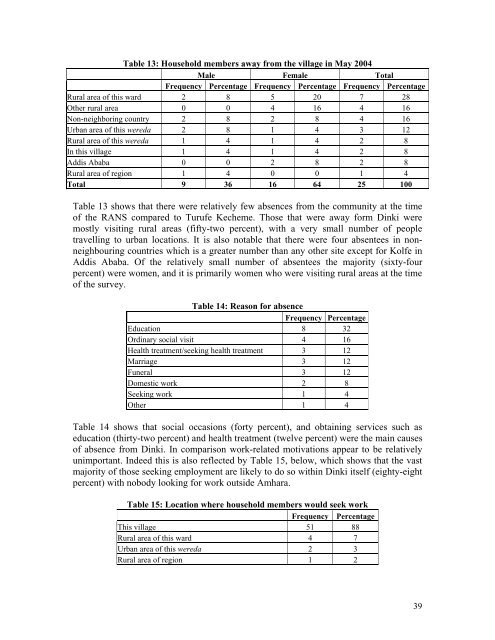Migration and Rural-Urban Linkages in Ethiopia
Migration and Rural-Urban Linkages in Ethiopia - Ethiopian Review
Migration and Rural-Urban Linkages in Ethiopia - Ethiopian Review
Create successful ePaper yourself
Turn your PDF publications into a flip-book with our unique Google optimized e-Paper software.
Table 13: Household members away from the village <strong>in</strong> May 2004Male Female TotalFrequency Percentage Frequency Percentage Frequency Percentage<strong>Rural</strong> area of this ward 2 8 5 20 7 28Other rural area 0 0 4 16 4 16Non-neighbor<strong>in</strong>g country 2 8 2 8 4 16<strong>Urban</strong> area of this wereda 2 8 1 4 3 12<strong>Rural</strong> area of this wereda 1 4 1 4 2 8In this village 1 4 1 4 2 8Addis Ababa 0 0 2 8 2 8<strong>Rural</strong> area of region 1 4 0 0 1 4Total 9 36 16 64 25 100Table 13 shows that there were relatively few absences from the community at the timeof the RANS compared to Turufe Kecheme. Those that were away form D<strong>in</strong>ki weremostly visit<strong>in</strong>g rural areas (fifty-two percent), with a very small number of peopletravell<strong>in</strong>g to urban locations. It is also notable that there were four absentees <strong>in</strong> nonneighbour<strong>in</strong>gcountries which is a greater number than any other site except for Kolfe <strong>in</strong>Addis Ababa. Of the relatively small number of absentees the majority (sixty-fourpercent) were women, <strong>and</strong> it is primarily women who were visit<strong>in</strong>g rural areas at the timeof the survey.Table 14: Reason for absenceFrequency PercentageEducation 8 32Ord<strong>in</strong>ary social visit 4 16Health treatment/seek<strong>in</strong>g health treatment 3 12Marriage 3 12Funeral 3 12Domestic work 2 8Seek<strong>in</strong>g work 1 4Other 1 4Table 14 shows that social occasions (forty percent), <strong>and</strong> obta<strong>in</strong><strong>in</strong>g services such aseducation (thirty-two percent) <strong>and</strong> health treatment (twelve percent) were the ma<strong>in</strong> causesof absence from D<strong>in</strong>ki. In comparison work-related motivations appear to be relativelyunimportant. Indeed this is also reflected by Table 15, below, which shows that the vastmajority of those seek<strong>in</strong>g employment are likely to do so with<strong>in</strong> D<strong>in</strong>ki itself (eighty-eightpercent) with nobody look<strong>in</strong>g for work outside Amhara.Table 15: Location where household members would seek workFrequency PercentageThis village 51 88<strong>Rural</strong> area of this ward 4 7<strong>Urban</strong> area of this wereda 2 3<strong>Rural</strong> area of region 1 239




![to read the full report [pdf, Amharic] - Ethiopian Review](https://img.yumpu.com/52737829/1/190x245/to-read-the-full-report-pdf-amharic-ethiopian-review.jpg?quality=85)











